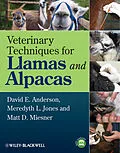Veterinary Techniques for Llamas and Alpacas provides a step-by-step guide to performing procedures in llamas and alpacas. Organized by body system, the book presents concise, visually oriented information to enable clinicians to treat these animals with confidence. With coverage ranging from basic maintenance such as restraint and catheterization to more complex procedures such as minimally invasive surgery, Veterinary Techniques for Llamas and Alpacas describes the full range of techniques required for the medical management of these species.
Each procedure is described in detail, with a consistent format for ease of use and accompanying photographs to illustrate the concepts described. A companion website offers videos of many of the procedures discussed in the book. Veterinary Techniques for Llamas and Alpacas is an essential resource for any veterinarian or technical staff member treating South American camelid patients.
Autorentext
David E. Anderson, DVM, MS, Dipl ACVS, is Professor of Large Animal Clinical Sciences at the College of Veterinary Medicine, University of Tennessee, Knoxville, Tennessee.
Meredyth L. Jones, DVM, MS, Dipl ACVIM, is Assistant Professor, Food Animal Field Services, College of Veterinary Medicine, Texas A&M University, College Station, Texas.
Matt D. Miesner, DVM, MS, Dipl ACVIM, is Associate Professor, Agricultural Practices Medicine and Surgery, College of Veterinary Medicine, Kansas State University, Manhattan, Kansas.
Klappentext
Veterinary Techniques for Llamas and Alpacas provides a step-by-step guide to performing procedures in llamas and alpacas. Organized by body system, the book presents concise, visually oriented information to enable clinicians to treat these animals with confidence. With coverage ranging from basic maintenance such as restraint and catheterization to more complex procedures such as minimally invasive surgery, Veterinary Techniques for Llamas and Alpacas describes the full range of techniques required for the medical management of these species.
Each procedure is described in detail, with a consistent format for ease of use and accompanying photographs to illustrate the concepts described. A companion website offers videos of many of the procedures discussed in the book. Veterinary Techniques for Llamas and Alpacas is an essential resource for any veterinarian or technical staff member treating South American camelid patients.
Key features
- Presents a complete, well-illustrated patient-side manual for veterinary techniques in llamas and alpacas
- Offers authoritative guidance on how to perform varying procedures, based on the authors' wide range of experience
- Covers techniques ranging from basic to advanced
- Provides color photographs throughout to depict specific steps
- Aids veterinarians and technicians in confidently performing veterinary techniques in these species
- Includes a companion website offering videos of many of the procedures described at www.wiley.com/go/andersonveterinary
Inhalt
Preface ix
About the Companion Website xi
Section I Behavior and Capture Techniques
1 Behavior and Capture Techniques 3
David E. Anderson
Section II Physical Restraint and Injection Sites
2 Haltering 11
Meredyth L. Jones
3 Manual Restraint 15
David E. Anderson
4 Chute Restraint 23
Meredyth L. Jones
5 Ear Squeeze (Ear Twitch) 27
Meredyth L. Jones
6 InjectionsSubcutaneous (SC), Intramuscular (IM), Intradermal (ID), Intravenous (IV) 29
Meredyth L. Jones
Section III Chemical Restraint and Anesthesia
7 Sedation and Tranquilization 35
David E. Anderson
8 Injectable Anesthesia 39
David E. Anderson
9 Orotracheal Intubation 43
David E. Anderson
10 Nasotracheal Intubation 47
David E. Anderson
11 Percutaneous Tracheal Intubation (Also Referred to as Retrograde Tracheal Intubation) 51
Matt D. Miesner
Section IV Catheterization
12 Vascular CatheterizationJugular Vein 57
Meredyth L. Jones
13 Vascular CatheterizationCephalic Vein 63
Meredyth L. Jones
14 Vascular CatheterizationSaphenous Vein 65
Meredyth L. Jones
15 Vascular CatheterizationLateral Thoracic Vein 67
Meredyth L. Jones
16 Vascular CatheterizationAuricular Artery and Vein 69
Meredyth L. Jones
17 Vascular CatheterizationFemoral Artery 71
Meredyth L. Jones
18 Intramedullary Cannulation of the Femur for Administration or Parenteral Fluids 73
David E. Anderson
19 Intraperitoneal Cannula for Plasma or Fluid Administration 77
David E. Anderson
20 Caudal (Sacro-coccygeal) Epidural Anesthesia 81
Matt D. Miesner
21 Epidural Catheterization 83
Matt D. Miesner
22 Lumbo-Sacral Epidural Anesthesia 89
Matt D. Miesner
Section V Head and Neck
23 Anatomical Features of the Head and Neck 95
David E. Anderson
24 Dental Examination and Trimming 99
Meredyth L. Jones
25 Tooth ExtractionOral Approach 105
David E. Anderson
26 Tooth ExtractionLateral Approach to Premolars and Molars 111
David E. Anderson
27 Examination of the Ear 117
Matt D. Miesner
Section VI Skin
28 Anatomical Comments on the Skin 123
Matt D. Miesner
29 Skin Scraping 127
Meredyth L. Jones and Patricia Payne
30 Skin Biopsy 131
Meredyth L. Jones
31 Toenail Trimming 135
Meredyth L. Jones
Section VII Respiratory
32 Thorax Anatomy and Auscultation 141
Matt D. Miesner
33 Tracheotomy/Tracheostomy 143
Matt D. Miesner
34 Field Diagnosis of Choanal Atresia 147
David E. Anderson
35 Transtracheal Wash 151
Matt D. Miesner
Section VIII Abdomen
36 Anatomical Comments on the Camelid Abdomen 157
Matt D. Miesner
37 Abdominal Ultrasound 161
Matt D. Miesner
38 Abdominocentesis 167
Matt D. Miesner
39 Liver Biopsy 171
Meredyth L. Jones
40 First Compartment Paracentesis (Rumenocentesis) and Fluid Evaluation 175
Meredyth L. Jones
41 Intubation of the First Forest...
